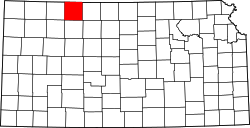19th century
In 1802, Spain returned most of the land to France, but keeping title to about 7,500 square miles. In 1803, most of the land for modern day Kansas was acquired by the United States from France as part of the 828,000 square mile Louisiana Purchase for 2.83 cents per acre.
In 1854, the Kansas Territory was organized, then in 1861 Kansas became the 34th U.S. state. Norton County was founded by Noah H. Billings, Thomas Beaumont, Henry Gordon, P. Hansen, and George Cole on August 22, 1872. In 1878 Norton became the county seat. The county gets its name for Civil War soldier Orloff Norton of the Fifteenth Kansas Cavalry, who was killed at Cane Hill, Arkansas in 1864. [4] [3]
The initial organization of Norton County in 1872 was fraught with deceit. N.H. Billings, aiming to exploit the county government for personal gain, submitted a forged petition to Governor Harvey, claiming 600 inhabitants when there were only 8 verifiable residents. After the governor initially rejected this, another fraudulent petition was sent, leading to the appointment of a fictitious census taker, Richard M. Johnson, which resulted in a fabricated census. This census allowed for the proclamation of Billingsville as the temporary county seat and the appointment of county officers. An election followed where Norton was declared the county seat, and various county officials were elected, including Billings, who engaged in further manipulation regarding school bonds and legislative actions. [3]
The first settlers arrived in 1871, with George Cole securing the first homestead. The influx of settlers increased in 1872, though the area was not entirely safe from Native American activity, leading to several "Indian scares." Community services began to establish with the first school in 1873, taught by J. H. Simmons, and the first physician, Mrs. P. A. O. Briggs, who was known for her dedication to patients regardless of their ability to pay. Despite the early fraudulent population claims, by 1880, the real population had grown but was still significantly less than the initial bogus census count. [3]
The first county fair, although not official, was held in Leota in October 1878. After 1900 the fair was held yearly in Elmwood Park in Norton. The first school district was formed in Norton in 1872. School was held in a dugout beginning December 1, 1873. [5]
21st century
In 2020, Norton County became a major hotspot in the COVID-19 pandemic. In July, an inmate at the Norton Correctional Facility, a state prison, tested positive for coronavirus. [6] By mid-October, more than 130 cases had been reported at the prison. [7] On October 19, officials announced that all 62 residents of the Andbe Home nursing home in Norton had tested positive for COVID-19, 10 of whom had died. [8] As of October 20, Norton County had the highest rate of infection over the previous 7 and 14 days of any county in the United States. [9] [10]





